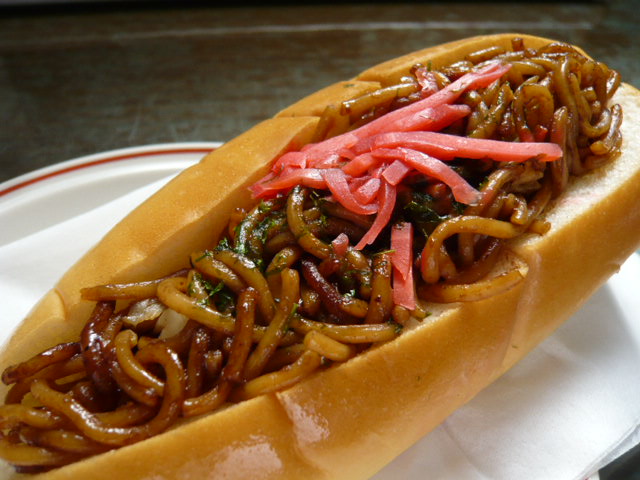Yakisoba - literally "fried noodles", it's sometimes served with a bit of pork and pickled ginger.
 |
| Image Credit: www.photoree.com I'm just realizing I never posted about "plastic food" |
Something we haven't tried (and don't have a lot of interest in trying), but can be found in most convenience stores is the yakisoba sandwich - a massive carbo load. "Yakisobapan"
 |
| Image Credit: www.ifood.tv |
Gyoza - fried dumpling (potsticker), usually with minced pork filling. Eat these fast around Maximo. He loves them and will try to eat more than you!
 |
| Creative Commons Image by Roger T Wong via Wikimedia |
Takoyaki - a ball shaped pancake (like a fritter, but not fried) with octopus on the inside. Another thing I like "nashi" (without) mayonnaise. It's usually covered in a sauce and bonito flakes.
 |
| Image Credit: www.mamaloli.com |
Painters Outfits
 |
| Image Credit: www.flickr.com by Kelly McCormick |
 |
| Image Credit: www.news.3yen.com |
Wasabi Almonds - I can't believe I don't have a picture of them. We get them from a local sake brewery. They are so, so good!
Momoji (cakes) - Momoji are maple leaves. In Miyajima, they specialize in these little cakes, which have different flavored centers. I like custard and chocolate, but bean paste is also yummy!
 |
| Image Credit: www.21food.com |
Kobe Beef - It's so good. We're going to take you to our favorite place!
 |
| Image Credit: www.keioplaza.com |
 |
| Image Credit: www.nationmultimedia.com |
There are also many places which we haven't even begin to talk about, but we didn't really want to spoil it for our family. We want them to experience these places first hand, in real life, not through photos on our blog. Barely off the plane, I'll whisk them off to Hiroshima and Miyajima (as long as the typhoon stays away).
We'll also go to other amazing places, which are all day trips from our house:
Kyoto - including the Golden Pavilion and Nishiki Markets (KNIVES!)
Arashiyama - we'll see the monkeys, bamboo forest and walk around town
Miyajima - oysters, deer, the beautiful torii gates, many temples, a great little island!
Nara - Todaji temple, more deer, gardens, parks. Japan's first capital city.
I've enjoyed writing these posts, even during a hectic time of the school year, with multiple trips.
Hopefully, in the future, I will add in a few more "Living in Japan" posts to our normal posts which are smattered with pictures of our kids and our travels in Japan and throughout Asia.
Come to Japan... it's an amazing place.
No we're going to try to squeeze in all 30+ of these posts + more into 14 days. Let's see how we do!








































